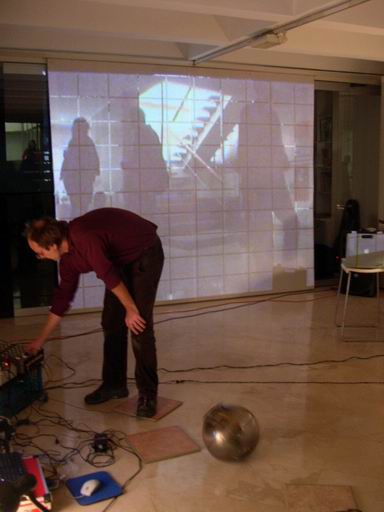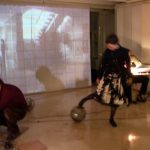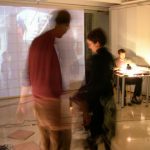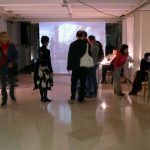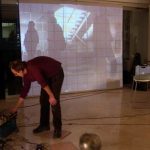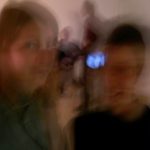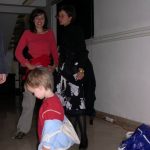[original at https://www.turborebop.net/borut_galerija/index.php?folder=performances/Bowlfuls_of_Sound]
Bowlfuls of Sound | Posodi polni zvoka
Posodi polni zvoka je bila predvidena struktura nastopa v Moderni galeriji v Ljubljani (september 2005). Kljub (ponovno) problematični izvedbi (gibljiva objekta – dve posodi, nista bila končani pravočasno…), pa sama struktura drži tudi za prihodnost.
Bowlfuls of Sound is the name of the structure of event at the Modern gallery in Ljubljana (september 2005). In spite of the (again!) problematic realization (two moving objects – bowls, were not finished by the time of the performance…), the strucure itself holds (water) for the future.
All photos were taken by Roni…
Description of the two objects will be presented here…
Some mp3 excerpts are here:
track 1
track 2
track 3
track 4
track 5
track 6
track 7
O FLUIDNEM PROSTORU
Kljub predvidoma samostojni zaključenosti (pojavne estetike) nastopa trojice Borut Savski, Luka Prinčič in Matjaž Manček (zvočni / glasbeni nastop = koncert), pa je morda vseeno vredno opozoriti, identificirati posamezne kose, ki sicer bolj ali manj neodvisni, združeni skupaj tvorijo koncept (strukturo / zgradbo / dramaturgijo) dogodka.
Izhodiščni domislek o dveh gibajočih se, eno na drugo nanašajočih se kroglah (-> posodah, polnih zvoka), se na koncu (tega besedila) sestavi s pričujočim razmislekom o fluidnem prostoru, ki naj bi ga na zvočnem dogodku vsi mi začutili in zaradi neposredne izkušnje morda tudi doživeli kot morebitni katarzični moment.
Fluidnost (tekočinskost, pretočnost) seveda “merimo” v zvočnem polju (ker smo pač zvočni umetniki). Fluidnost pomeni, da lahko prisotne mase razmeroma lahko prehajajo ena mimo druge, se skupaj vrtinčijo, poljubno krožijo, usodnejših trkov (-> konfrontacij) pa zaradi mehkosti materiala pravzaprav ni. Dinamične spremembe v poljubnem od prisotnih objektov / zvokov se mehko prenesejo do roba prostora, nekje doživijo resonanco, drugje pa se omilijo. Seveda govorim predvsem v metaforičnem jeziku – v prenesenem pomenu – o svetu, ki bi bil mehkejši, poljubnejši, bolj odprt.
Nasproti kakršni koli fluidnosti namreč stoji (ali: pred stanjem fluidnostjo obstaja) – trdnost. Trdnost nespremenljivih relacij, velikih inercij – inertnega prostora. Prostora, v katerem se nič ne zgodi, kjer je vse jasno, vsa vprašanja pa imajo odgovore. Mera inertnosti so inercije, ki vztrajajo med relacijami veličin / objektov / entitet v prostoru. Spreminjajo se počasneje, kot pa jih mi dojemamo, zato se zdijo nespremenljive. Utekočinjanje določenih relacij pomeni zmanjšanje odzivnega časa soodnosov, zmožnost zaznavanja pretakanja časa.
A vendarle šele zunanja (trdna) točka omogoči meritev – uvid v spremembe. Zato je potrebna konstrukcija situacije – dogodka.
Konstrukcija / kompozicija zapoveduje:
Dve kroglasti posodi sta opremljeni z enostavno motoriko in bolj kompleksno senzoriko. Občutljivi sta za zvok, ki ga slišita, a ga tudi proizvajata (nadzirana mikrofonija). Od tod tudi teza, da sta posodi polni zvoka. Eno drugo lahko tudi zaznata (infrardeči senzor) in tedaj spremenita smer. To naj bi omogočilo postopno cikcakasto približevanje posod, kar pa nas ne zanima več, a za posodi je to nekaj, čemur lahko rečemo vodilo / motiv (pri človeku bi to imenovali celo smisel). Preprosta samonanašajoča se algoritmika proizvede / rodi nekakšno avtonomijo stroja.
Dve opisani kotaleči se krogli tako postaneta ovčici in potrebujeta pastirja. Vendar je bil pastir (s palico) prisoten že prej! To je želja muzikanta, ki je imel željo po konkretnem zvoku – rezek, glasen udarec s palico. POsodi tako zaradi pastirja postaneta ovčici. Palica ob dodatku zvočno občutljive podlage postane glasbeni inštrument. Prav to pa lahko določi tudi kvaliteto preostalega igranja. Mehak zvok posod in rezkost udarcev ob tla in po strunah.
Tretja entiteta (ker smo muzikanti trije) se je kristalizirala okoli manipulacije podobe in pretvorbe v zvok. To algoritmiko poganjajo vizualni podatki neposredno s samega prizorišča, tako da smo v ta segment kot spremeljivke vključeni vsi prisotni. Projekcija nas samih v prostor pred / za nami bi lahko bila priložnost za nov aspekt, a bodi dovolj. K fluidnosti bomo dodajali še z enim pomagalom – s spreminjanjem položajev posameznik zvokov med štirimi zvočniki.

